Switzerland is not just famous for its alpine scenery, lush meadows and towering mountains. If you want to know what to eat in Switzerland when you’re not busy ticking off your list of top things to do, here are some really delicious and mouth-watering Swiss dishes you must try.
1. Meringues, fresh raspberries, and the famous Gruyeres Double Cream!
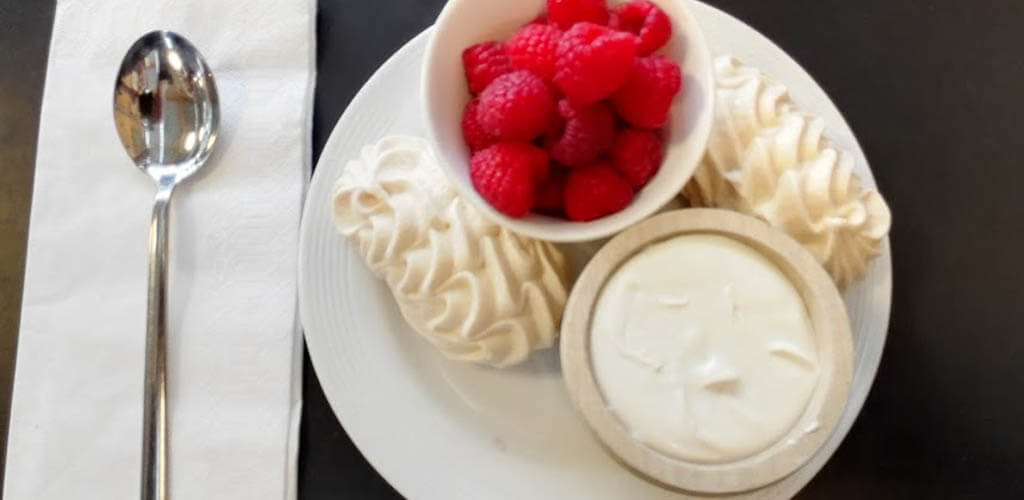
Pic by Maureen from So Many Places! So Little Time!
Gruyeres in Switzerland is best known for its cheese and its cheese is very delicious and world-famous. When you’re in Gruyeres you can visit the excellent cheese factory which is located by the railway station and it’s well worth a visit, but there’s so much more to Gruyere than the cheese!
20 minutes walk up the hill is the Gruyeres castle alongside the very charming medieval village of Gruyere. The cafes here specialize in traditional local food from the Fribourg area, such as fondues, rostis, and dishes from the Bénichon menu.
There is a Fondue Academy run by master cheesemakers that give visitors the chance to learn about the art of fondue. If you’re a chocoholic you can reserve a place in a workshop at the Chocolaterie de Gruyères.
But we quickly became addicted to the “creme double de la Gruyere”- the local double cream – served with fresh raspberries, and meringues.
The double cream is unique. It is made from high-quality milk from selected farms in the Gruyeres region and has a very high butterfat content. It is always served in a traditional wooden bowl. Gruyeres even holds a Double Cream festival annually.
The meringues are small oval-shaped and perfectly piped. Unlike most meringues with their crunchy outer layer and soft inside the Gruyeres meringues have the same texture throughout and simply crumble in your mouth. Totally Addictive!
By Maureen from So Many Places! So Little Time!
Catch up with So Many Places! So Little Time on Facebook here!
2. Maluns
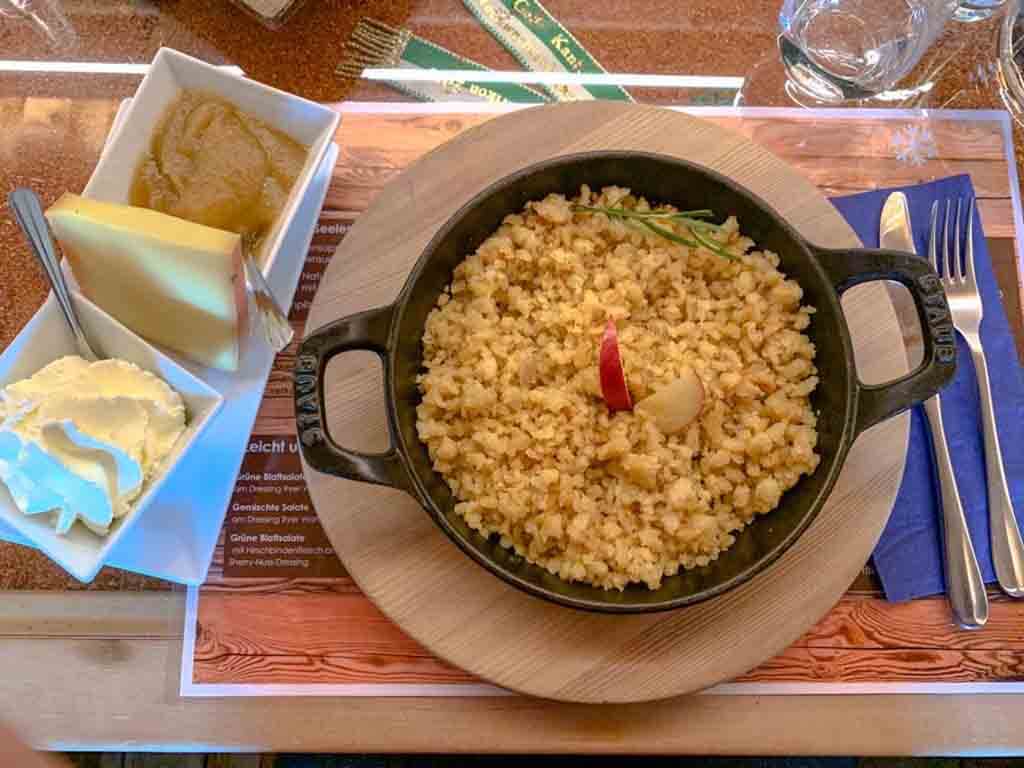
Pic by Greta from Greta’s Travels
Maluns are a traditional Swiss dish made of crumbly potato nibbles, which are covered in flour and butter and then fried, served with cheese, cream, and apple or cranberry sauce. You will find similar variations of this dish served all over Switzerland, but it originated in Graubuden, a canton in Easter Switzerland.
Back in the 1700s the lord of Marschlins Castle, Johann Gubert Rudolf von Salis, introduced potatoes and corn to the region. The Maluns dish was born as a way to use leftover boiled potatoes and avoid wastage.
The combination with cheese and fruit sauce makes it a filling and hearty meal; an essential given the hard labour and conditions of the time. I tried this dish while on a skiing trip in Davos and can say it was the perfect meal after a long day out on the slopes!
It’s a very filling dish, which is why it’s served as a main dish despite being very sweet. The potato in itself can be quite dry, so make sure to add plenty of sauce and cream to it to make it more enjoyable.
Maluns is not only a tasty meal, but also a traditional dish with a strong Swiss history, and something you definitely have to try when you travel to Switzerland.
By Greta from Greta’s Travels
Catch up with Greta’s Travels on Facebook here!
3. Züri Gschnätzlets
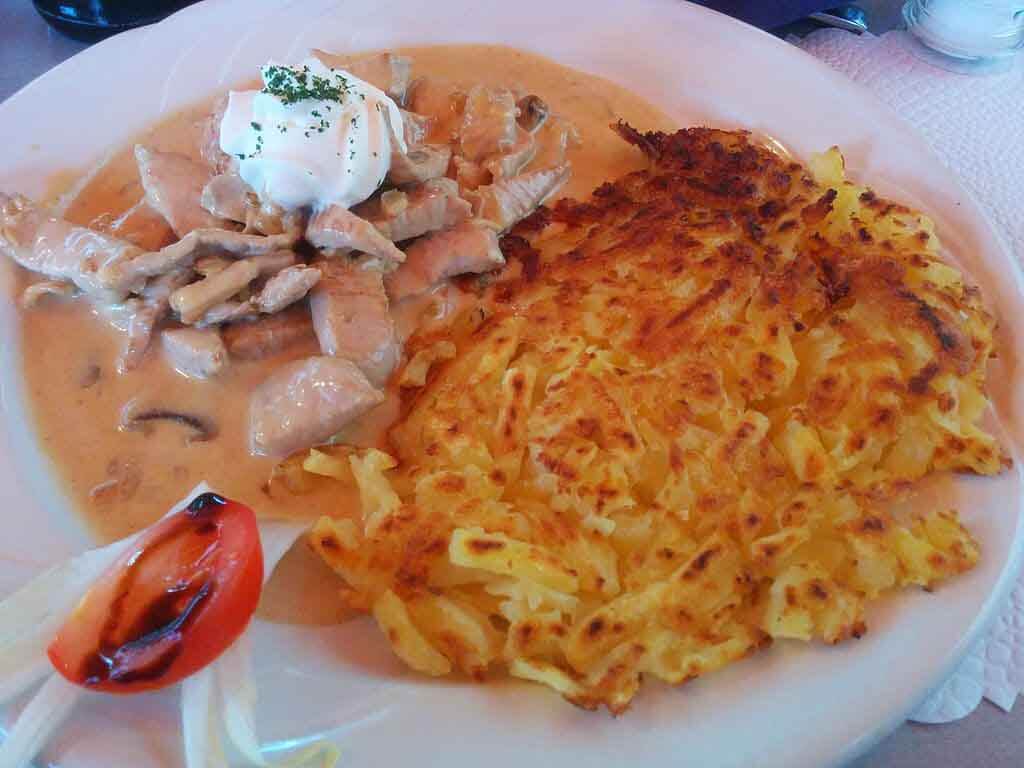
Pic by Jpatokal from Wiki Commons CC-BY-SA-3.0
When you visit Switzerland, chances are, at some point, you’ll find yourself in Zurich, home of the Zürcher Geschnetzeltes (or Züri Gschnätzlets in Swiss German).
The dish is particularly popular in the Zurich region and is considered a must-eat dish on Sechseläuten, the city’s annual Spring holiday. It consists of thinly sliced, pan-fried veal topped with a creamy white wine sauce. Sliced mushrooms are often added to the sauce, too.
The origins of the dish are not certain but Züri Gschnätzlets was first mentioned in a 1947 Swiss cookbook by Rosa Graf. The original version of the recipe didn’t include mushrooms but they have become a popular addition to today’s Zurich-style veal.
Many of Zurich’s restaurants feature Züri Gschnätzlets on their menu and I enjoyed a delicious meal at Zeughauskeller, an old armory, in the Old Town.
Served with an accompaniment of rosti, the melt-in-your-mouth veal and the creamy mushroom sauce was one of the best meals I’ve ever eaten.
You’ll find slight variations to the recipe at different restaurants across the city but if you like to sample the local cuisine when you visit a new place, enjoying a meal of Züri Gschnätzlets is definitely one of the best things to do in Zurich.
By Carolyn from Holidays to Switzerland
Join the Holidays to Switzerland group on Facebook here!
4. Älpermagronen
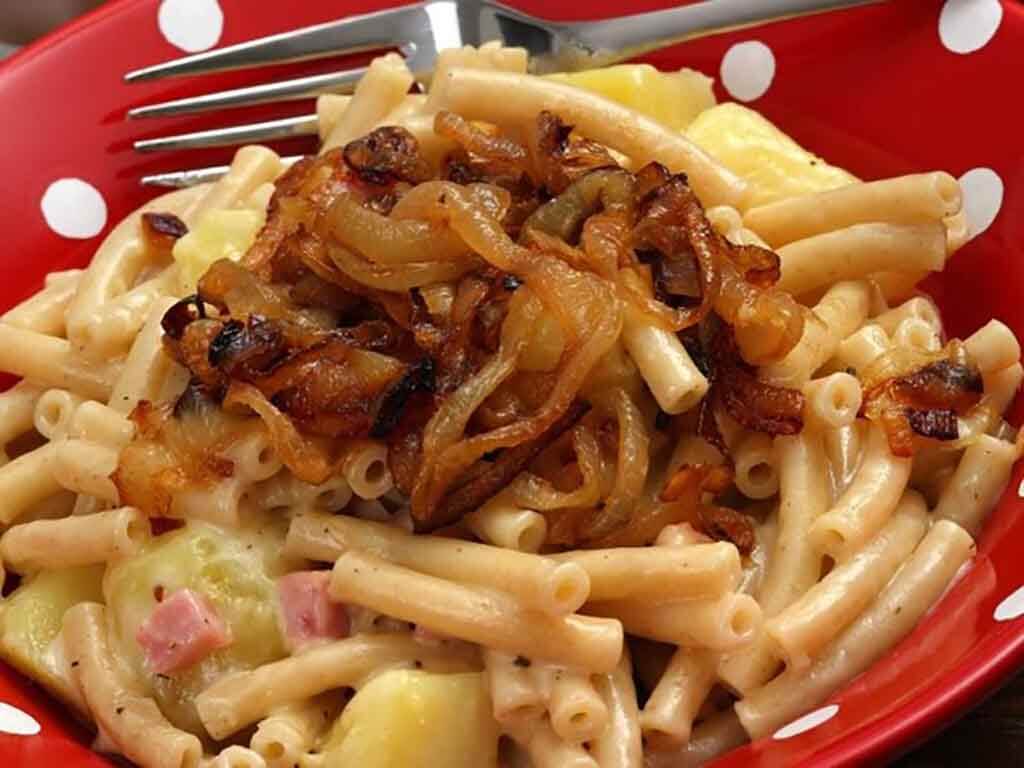
Pic by Tracy from Tracys Travels in Time
Älpermagronen is a hearty Swiss dish which consists of layers of macaroni pasta, potatoes, cheese (preferably Gruyère or another hard cheese) and cream which are placed in a pot and baked in the oven.
As the name suggests this delicious dish originates from the Alpine regions of Switzerland – Älper means Alps and Magronen means pasta or macaroni in Swiss German.
Älplermagronen is a very rich dish and calorie heavy which was perfect for the hardworking Swiss farmers (and great for skiers and hikers too).
The dish consists of ingredients readily available to farmers – milk, cream, cheese and potatoes with the addition of pasta which could be stored. Cooked in an oven once the älplermagronen is bubbling hot and golden on top it is served with caramelized onions and apple sauce.
Älplermagronen is the perfect hearty dish to serve during the cold winter months and one you will find served in many Swiss mountain restaurants and resorts. There may be some variations depending on location with different hard cheeses used or bacon added but one thing is certain Älplermagronen is absolutely delicious!
By Tracy from Tracys Travels in Time
Catch up with Tracys Travels in Time on Facebook here!
5. Rosti
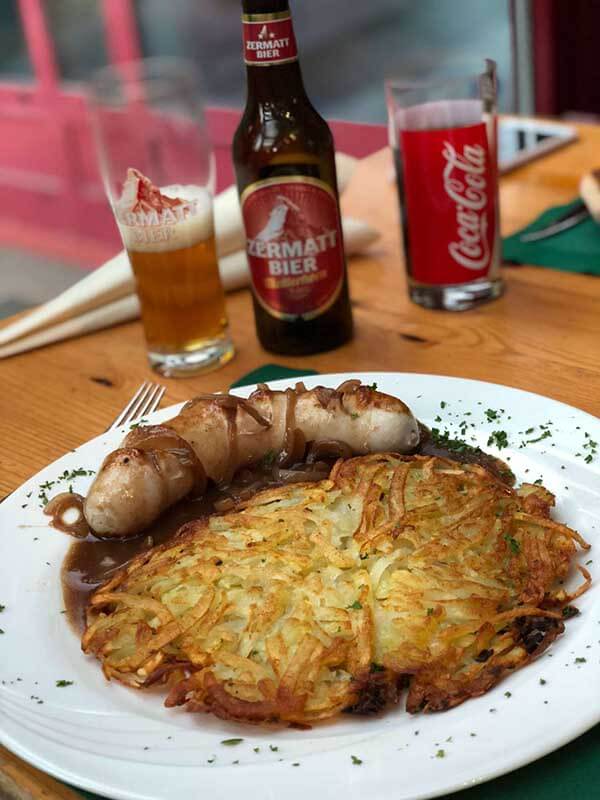
Pic by Jeff from Our Passion For Travel
If you find yourself in the shadow of the mighty Matterhorn in Zermatt, you’ll want to make sure you have the right dining experience to match the majestic views. You can look no further than the traditional Swiss rosti. A hearty, somewhat heavy dish, the rosti calls the canton of Bern home. However, it’s popular throughout Switzerland.
Made of grated potatoes, mixed with oil and butter, the rosti is typically fried in a circular pan. Throughout Switzerland, you’ll find the Swiss like to add a variety of ingredients to add some additional taste. Onion and eggs are often used, and most common is bacon and cheese which makes for a salty, cheesy, gooey concoction.
You’ll find the rosti crispy on the outside, and a softer mix inside not dissimilar to the interior of a hash brown. Often served as a shared accompaniment, it can be equally enjoyable as a main meal itself.
Most restaurants will have their version of rosti available. If you stumble across a market, you’ll no doubt find a stall with a home-made style equivalent.
And unlike many meals you may stumble across on your travels, rosti is a dish that can be replicated, perhaps not perfectly, when you return home.
This warm dish will have maximum impact on a colder evening, a fitting reward perhaps for a traveller looking for respite after a day on the slopes.
By Jeff from Our Passion For Travel
Catch up with Our Passion For Travel on Facebook here!
6. Raclette
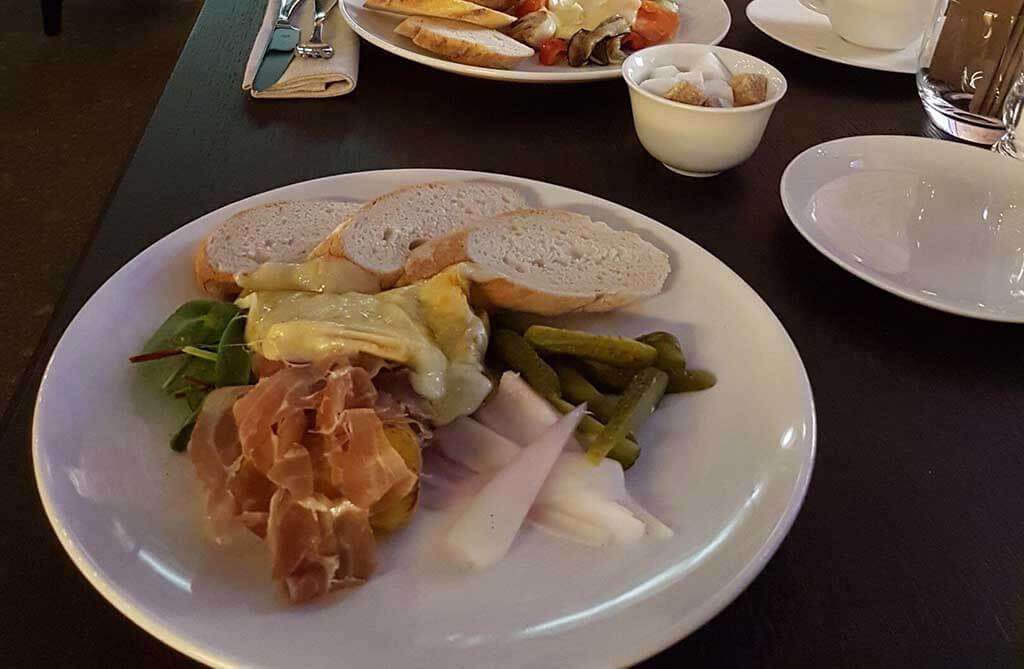
Pic by Ivan from Mind The Travel
Any visitors to Switzerland should try its famous semi-hard cheese made from the fresh milk of cows that have grazed on alpine pastures. While it differs in taste and texture from region to region, Valais is the place where it tastes absolutely incredible. Originally from the canton of Valais, raclette is a dish made from this very special type of Swiss cheese.
In fact, raclette is a both a cheese and a dish because as a dish it consists of boiled baby potatoes, pickled onions, gherkins (pickles), slices of cold meat, and sometimes pickled fruit.
Many Swiss families have their own uniquely designed raclette grills with little palettes on which individual slices of the cheese can be heated.
Traditionally cheese is melted over a wood or charcoal fire, and as each layer melts, you scrape off the melted par onto accompaniments like pickled onions, vegetables, jacket potatoes, and meat. Raclette is usually accompanied by a glass of Fendant.
Raclette must be eaten slowly. If you’re in a hurry opt for a sandwich instead. Raclette sets apart gourmets who know how to switch off and relax. Raclette is for everyone in search of genuine simplicity, togetherness, complicity without obligation.
Many ski resorts’ hotels and restaurants in Geneva, Matterhorn, Zermatt have their own raclette nights during which guests can indulge in festive eating and enjoy this delicious experience.
By Ivan from Mind The Travel
Catch up with Mind The Travel on Facebook here!
7. Brezels
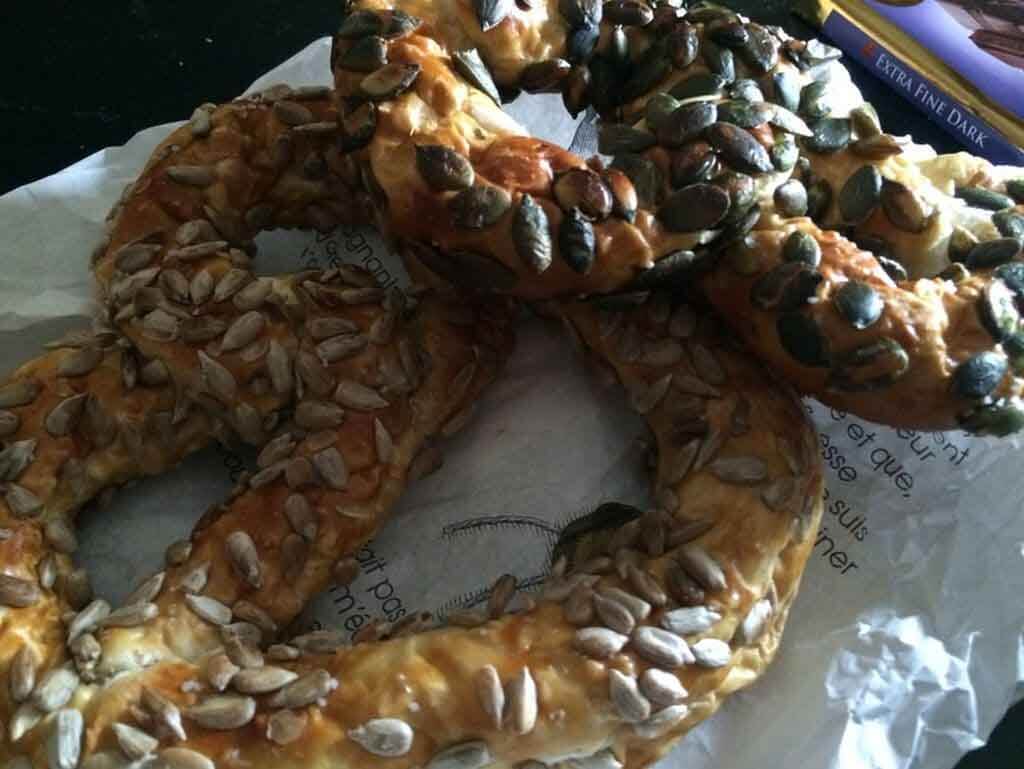
Pic by Wendy from The Nomadic Vegan
The word “pretzel” in English is actually derived from a local dialect of German spoken by the so-called “Pennsylvania Dutch” immigrants, who introduced these baked goods to the US.
The name in High German is “brezel”, and this is how they are known throughout Switzerland. We are talking here about large, soft pretzels, not the small, hard ones, which were invented in Pennsylvania, again by the Pennsylvania Dutch.
In Switzerland, a brezel is about the size of the palm of your hand, or a bit larger. They are sold in bakeries and in train stations all over the country, not just in the German-speaking parts but also in the French-speaking and Italian-speaking areas.
Brezelkönig (which means “brezel king” is a popular chain of bakeries that specializes in brezels. In addition to the plain ones sprinkled with salt, you can also find brezels covered in sunflower seeds, pumpkin seeds or poppy seeds.
They also come sliced and filled with meats and cheeses, serving as a quick takeaway lunch. While the fillings are usually animal-based, the plain and seed-topped brezels are made with just flour and water and are thus suitable for vegetarians and vegans visiting Switzerland.
By Wendy from The Nomadic Vegan
Catch up with The Nomadic Vegan on Facebook here!
8. Weinerschnitzel
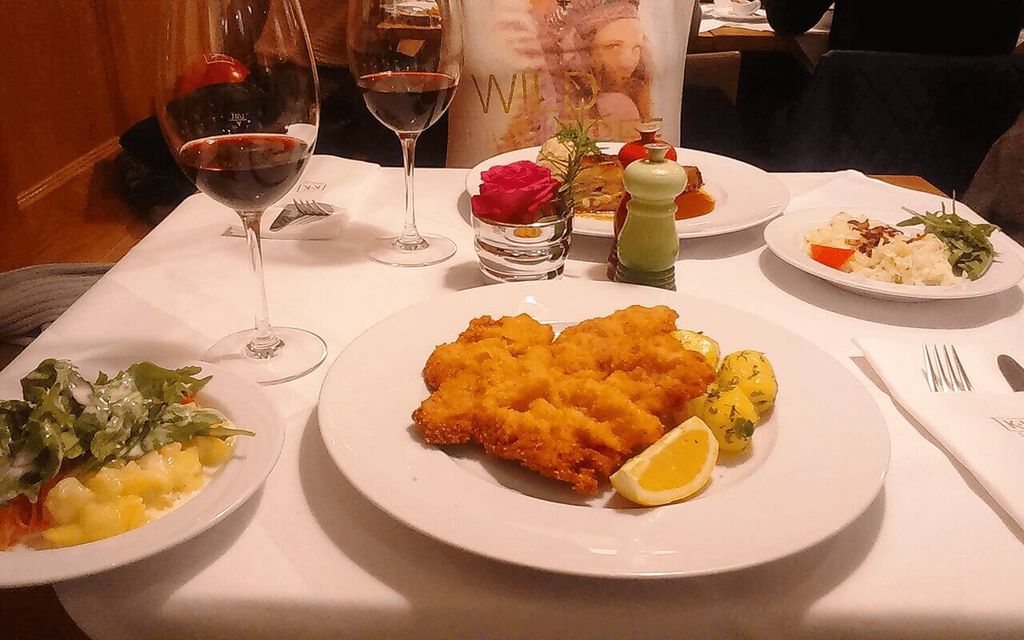
Weinerschnitzel is one of the national dishes of Austria and we loved splurging on it over there at the famous Restaurant K + K am Waagplatz in Salzburg, Austria. But we heard that Wiener-schnitzel is a must-have in Switzerland too, and decided to try it out in Zurich. And were too busy eating to take any pics. 😉
Weinerschnitzel is basically a thin cutlet made of veal meat that has been pounded and pounded and pounded. The meat is then rolled in a mix of flour, eggs and salt and fried with bread crumbs.
It is usually served with sauteed potatoes or potato salad and some lemon. Some restaurants serve the schnitzel with cranberry sauce or with sour cream. I prefer the version with the sauce, it’s quite delicious. So if you’re ever in Zurich and want a taste of Austria, try out the schnitzel. It’s widely available at restaurants or even food stalls.
By Sarah of TheWingedFork and Abby’s Plate
Catch up with us on Pinterest here!
9. Swiss Chocolate
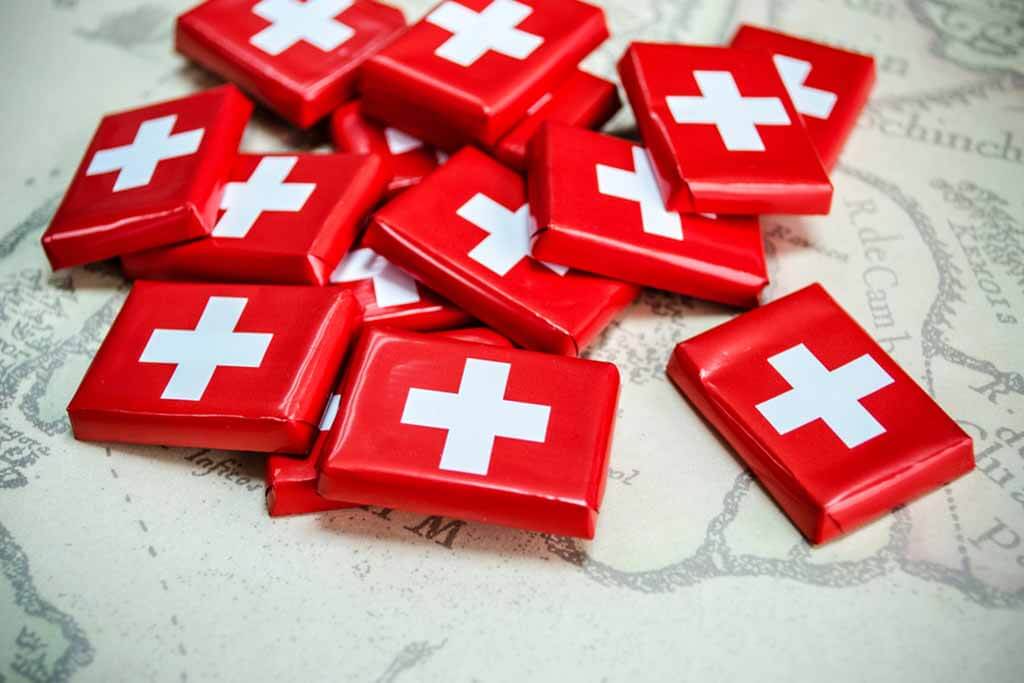
No one who goes to Switzerland should leave without tasting some exquisite Swiss chocolate. Whether you enjoy some hot cocoa in a cafe or go on a chocolate factory tour, there are so many great ways to enjoy chocolate in Switzerland.
But cocoa isn’t indigenous to Switzerland, so how did chocolate become synonymous with Helvetica? While chocolate was one of the food items Europeans brought back from their colonies in the Western Hemisphere, it wasn’t turned into the sweet confection we think of today until the early nineteenth century.
The first Swiss chocolate factory opened in Vevey. The company, Cailler, still operates today and is one of the Switzerland chocolate factories that you can tour on your trip! This first important chocolate brand is now owned by Nestle, but their recipes go all the way back to their first few batches.
Other important Swiss chocolate brands you will want to try on your trip include Suchard, Lindt, and Frey. Toblerone, the iconic Swiss chocolate candy you can find at almost any airport in the world, is said to be inspired by the shape of the famous Matterhorn peak in the Swiss Alps. And of course, it tastes even better in Switzerland than it does anywhere else.
By Stephanie from History Fangirl
Catch up with History Fangirl on Facebook here!
10. Mehlsuppe
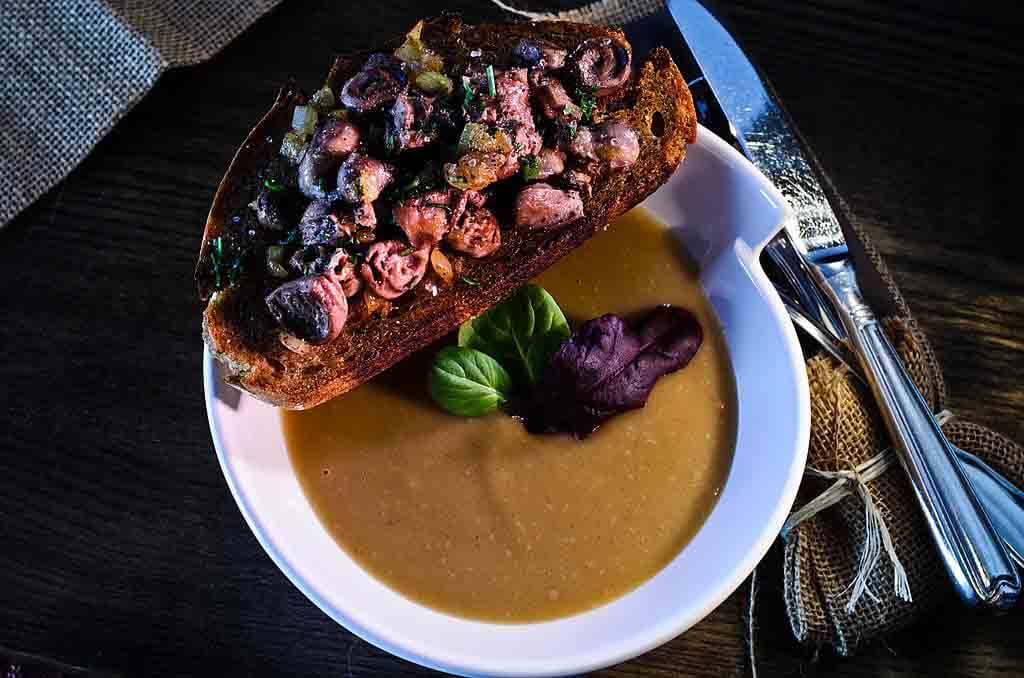
Pic by Stefan Muth from Wiki Commons CC-BY-SA-2.0
The name Basel flour soup, or as they call it: Mehlsuppe, does not quite do justice to this delicious soup.
Mehlsuppe is made from (surprise) flour, onions, bouillon, and white or red wine. As simple as the ingredients may sound, Basel flour soup, is more than just a plain soup made from flour and onion, you have to try it for yourself to find out!
White flour used to be one of the main imports coming through Basel, which is why it should come as no surprise that the citizens decided to use it for a warm soup during the cold Swiss winters.
It is said that Basel women were not allowed to marry until they had learned to make the perfect Mehlsuppe. Perhaps that’s the reason why you can find delicious soup everywhere, and the original recipe is still around.
The first Basel Flour soup is traditionally eaten at 4 in the morning at the Basel’s carnival called Fasnacht. Which the Baslers celebrate on the Monday after Ash Wednesday. However, tourists who happen to visit Basel or Switzerland on a different date can till try their luck at one of the many restaurants that serve Basel flour soup throughout the year!
By Lara from Both Feet On The Road
Catch up with Both Feet On The Road on Facebook here!
11. Cheese Fondue
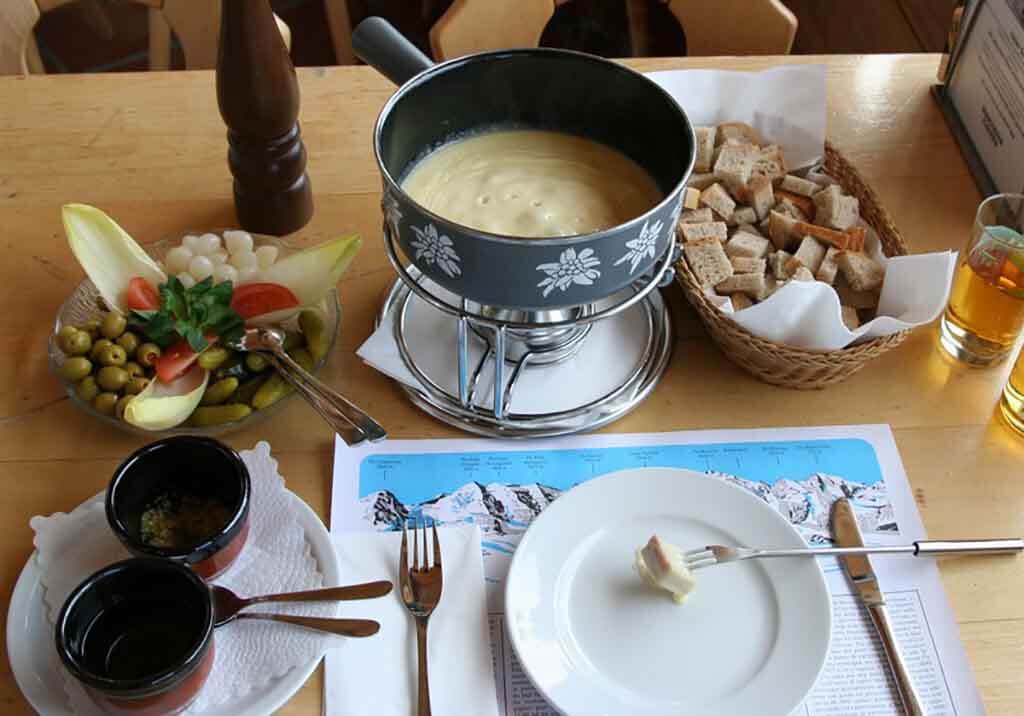
Pic by EquatorialSky from Wiki Creative Commons CC0
Fondue is a melted cheese dish from Switzerland that is served in a pot. The pot is heated over a portable stove. This molten hot cheese is then eaten by dipping bread into it using long-stemmed forks.
The earliest known recipe comes from a 1699 book published in Zurich, under the name “Käss mit Wein zu kochen”, which translates to “to cook cheese with wine”. It was described as grated or cut-up cheese to be melted with wine, and for bread to be dipped in it, which basically is the recipe for the traditional cheese fondue.
But beware of losing a piece of bread in the pot! If you do, you have to buy a round of drinks for the table. Don’t dare to neglect it as the legend says that if you don’t, you are cursed with seven years to bad sex life. It might just be a stupid legend but do you want to risk it?
It is recommended to drink white wine or tea with fondue which supposedly helps to digest the enormous amount of cheese.
My favorite variant of Cheese Fondue is Moitié-moitié (or half and a half), made up of Gruyère, and Fribourg vacherin cheese. Filling myself with cheese is one of the favorite things to do in Lausanne, Switzerland.
By Nisha from Nerdy Footsteps
Catch up with Nerdy Footsteps on Facebook here!
Aren’t these all lush? Have you tried any of these dishes on a visit to Switzerland? Which was your favorite dish? And what else do you think should be on this list?
Other Foodie Listicles You’ll Love reading
- Over 50 Best Street Food In Europe
- Indian Streetfood You Must Try
- Popular food to taste in African countries
- What to eat in Rome
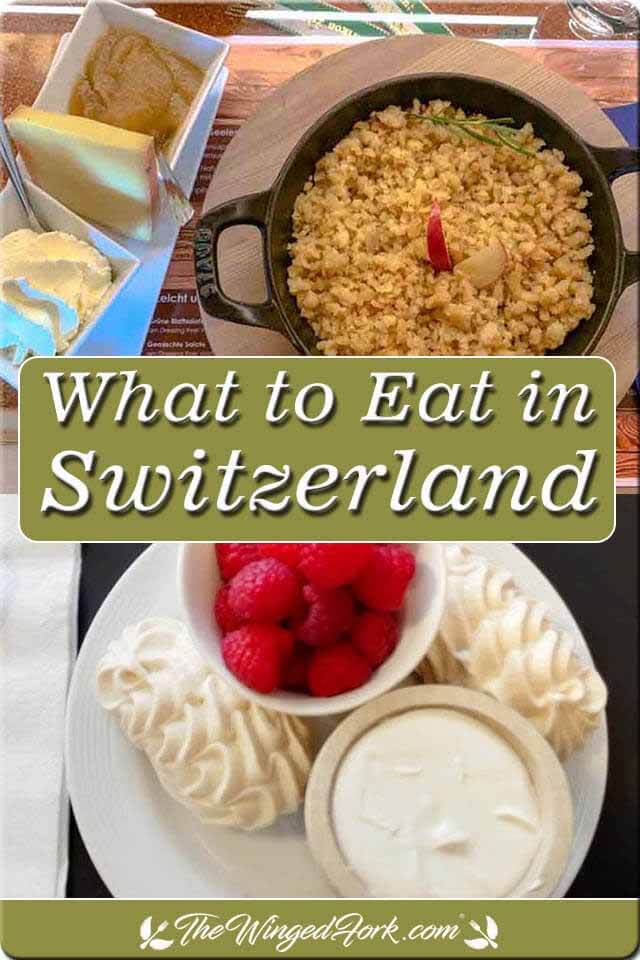
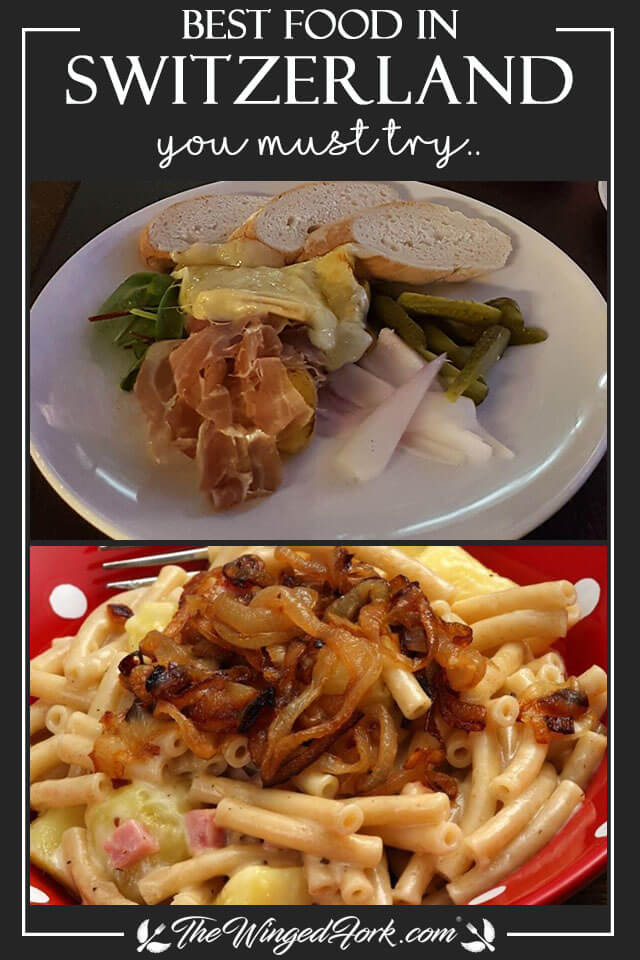
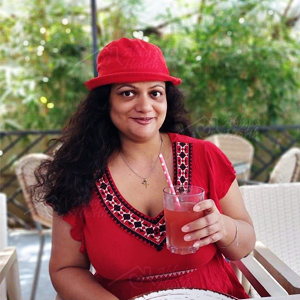
I’m an East Indian foodie and travel blogger from Bombay, India. I’ve travelled across parts of Europe and Asia, and love writing about my experiences with people and cultures. And naturally, I love food, wine, and travel, and have an endless bucket list of places to go to, and experiences I must blog about.
I also love baking and experimenting with food, with a little help from my family. If you must know, my favorite things are nice rainy days, the smell of cakes in the oven, playing in the snow, glasses of wine, and dark chocolate.
More info about me here!
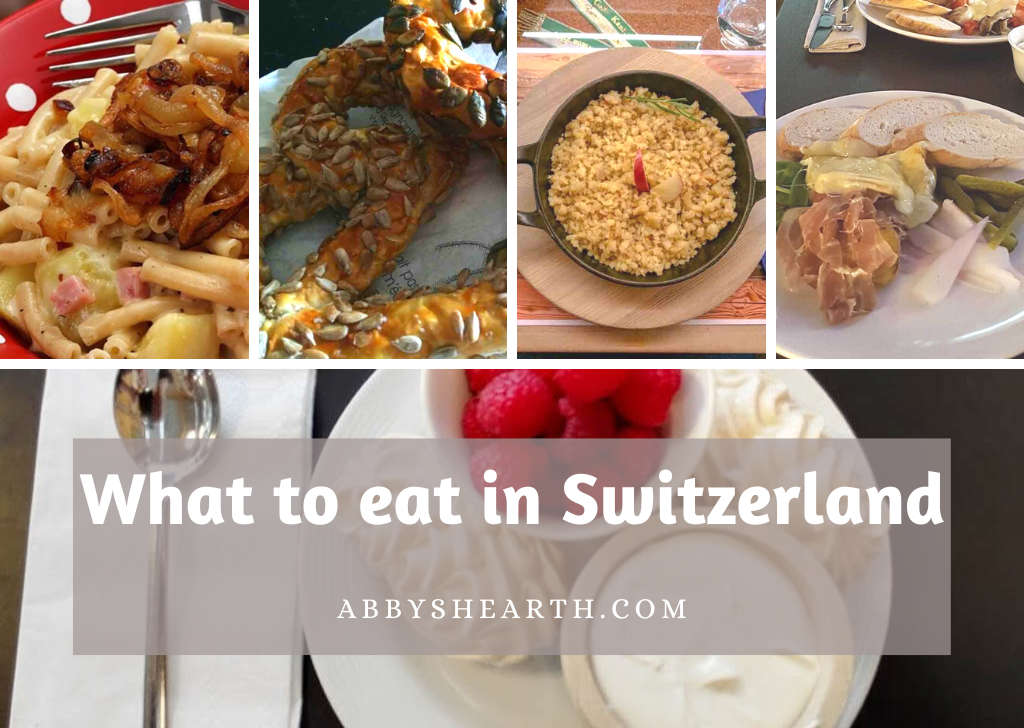
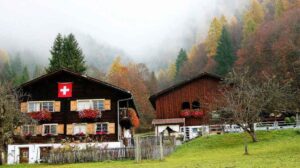
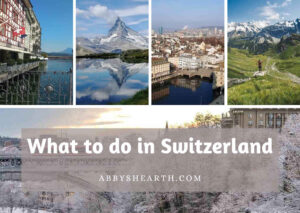
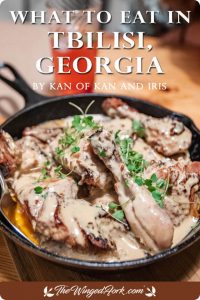
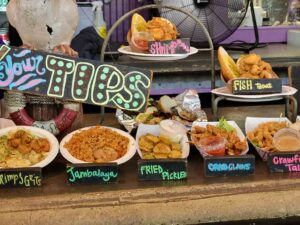
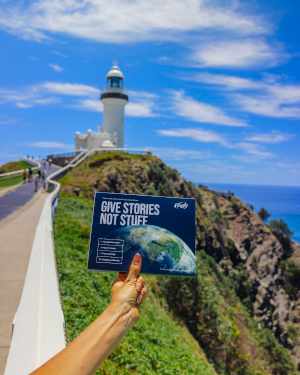
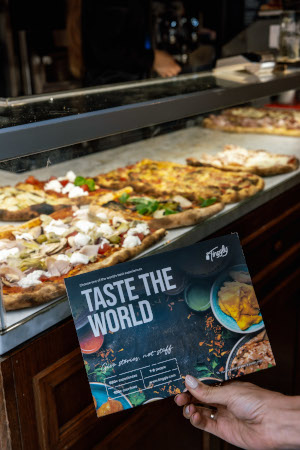
I had tried cheese fondue in Zurich, and I absolutely loved it. It is also the national dish of Switzerland.
Yes, fondue is lovely. I like it almost as much as the raclette. 😉
Excellent compilation; I wish there was an option of tasting each through my mobile screen.